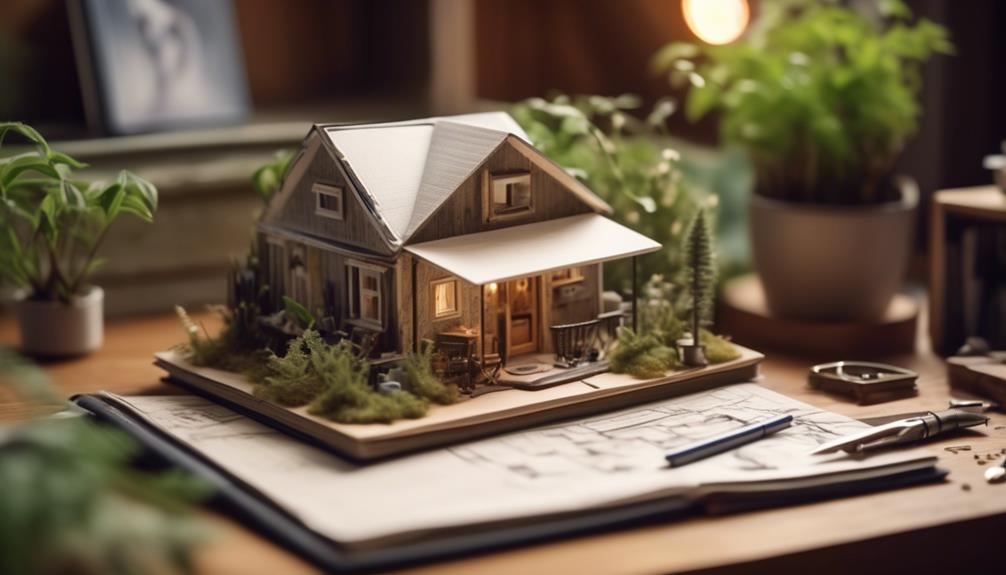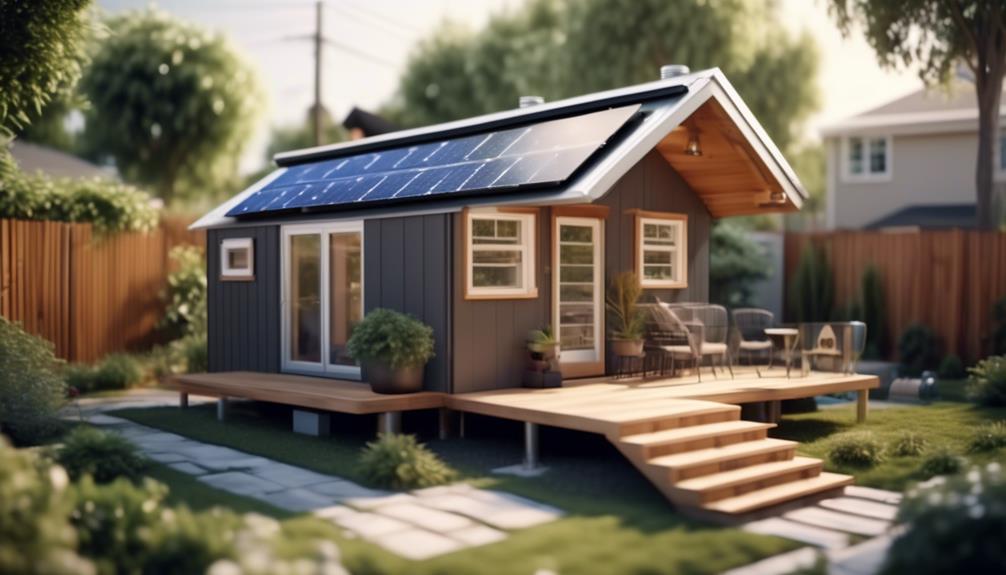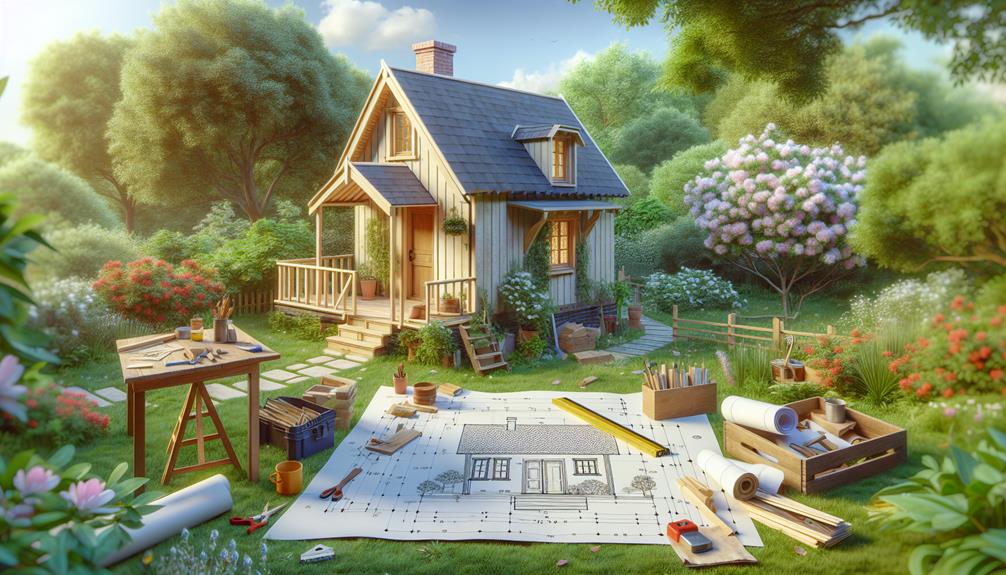As you embark on the journey of downsizing your living space, you're not just building a tiny home in your backyard—you're crafting a sanctuary that requires a unique blend of creativity and pragmatism.
You'll need to navigate the often murky waters of zoning regulations, ensuring your new abode complies with local laws, which can be as variable as the weather. Settling on a budget that reflects your financial comfort zone is just as important as the design of your compact haven.
As you ponder whether to go with a traditional foundation or a more mobile trailer-based structure, remember that the choices you make now will lay the groundwork for your future retreat. Your plans for water, power, and other utilities must be as meticulously designed as the home itself, and finding the right materials can turn into an adventure all its own.
How you'll manage these initial steps could determine the overall success of your project, so consider this the map to your tiny treasure—yet the 'X' that marks the spot is only the beginning of what promises to be an enlightening endeavor.
Key Takeaways
- Thoroughly research and understand local zoning laws and regulations to ensure compliance and avoid potential issues during construction.
- Create a realistic budget for the project, considering all costs and exploring cost-saving options such as DIY approaches and comparing prices for materials.
- Carefully design and maximize the use of space in the tiny home, considering lifestyle needs, vertical storage, and technology integration.
- Prioritize the choice of foundation, balancing budget and quality, and considering long-term maintenance and upkeep.
Understanding Zoning Laws
Before embarking on the construction of a backyard tiny home, it's essential to thoroughly investigate your local zoning laws to ensure your project adheres to all pertinent regulations. When you're planning to build a tiny house, understanding the intricate zoning laws and building codes specific to tiny homes is crucial.
These regulations can influence your Tiny House Design, dictating the maximum and minimum living space, and may subject your tiny house building to RV regulations. Consult with local authorities to clarify the exact requirements for building a tiny home, including potential restrictions on size, location, and usage. Moreover, research the necessity for permits or variances.
Compliance with these legal frameworks not only ensures the legality of your tiny house floor plans but also facilitates a smooth building process.
Budgeting Your Project
Having clarified the local zoning laws for your tiny home, it's now crucial to meticulously plan and allocate your financial resources for the construction phase of the project.
To build a tiny home, start by determining the total budget, accounting for construction, materials, and unforeseen costs. Researching and comparing prices for your Tiny House Plans is a smart way to save money. Additionally, when budgeting your project, allocate funds judiciously with a focus on essential construction elements and quality materials.
As a guide to building, consider a Tiny DIY approach as it can significantly reduce labor costs. For those less inclined to DIY, tiny home builders can offer a step-by-step guide tailored to your budget.
Regularly tracking and reviewing expenses ensures you remain on target, adjusting your budget as needed to prevent financial overextension.
Designing Your Tiny Home

When designing your tiny home, start by assessing your lifestyle needs to create a functional floor plan that aligns with your day-to-day activities and maximizes the limited space available. Your design should prioritize efficiency and innovation, incorporating multi-functional furniture and storage solutions.
To ensure a seamless tiny house construction, consider these critical elements:
- Maximize Space: Utilize vertical space and hidden compartments.
- Floor Plan: Optimize the layout for comfort and utility.
- Interior Design: Select decor that enhances the sense of space.
- Building Your Tiny: Tailor construction methods to fit a large shed-sized footprint.
- Tiny House Interior: Integrate technology for smart living.
Carefully source materials and plan logistics for installing key systems, from plumbing to HVAC, to support a sustainable and comfortable tiny house interior.
Choosing a Foundation
Selecting the appropriate foundation for your tiny home is a critical decision that affects both the durability and stability of your structure. As you embark on building your tiny house, the foundation is the place to start, anchoring the mere square feet of your Tiny Life dreams to solid ground.
This guide will aid you in understanding the balance between budget constraints and the quality of homes built.
Expertise is paramount; enlist skilled professionals to construct your tiny house foundation, ensuring it's executed correctly and safely. Factor in the full spectrum of costs, from materials to labor. Remember, constructing a foundation isn't a one-off task—it demands foresight for ongoing upkeep.
Additionally, anticipate lifestyle adjustments when choosing your foundation, as this choice will influence your tiny house experience long-term.
Planning for Utilities

Before installing your tiny home's essentials, you'll need to map out a clear plan for connecting utilities such as water, electricity, and sewage, while adhering to local building codes and regulations. As you build your tiny house, consider the technical aspects of utility installation:
- Water Supply: Explore on-grid connections or off-grid water systems.
- Electricity: Determine whether to connect to the main grid, install solar panels, or use RV hookups.
- Sewage: Plan for a full bathroom with connections to the municipal sewer or design a septic system.
- Ventilation: Install house wrap to regulate moisture, and ensure detectors for carbon monoxide are in place.
- Safety Compliance: Ensure all utility installations meet safety standards to prevent hazards in your backyard tiny home.
Getting started with planning is crucial to a seamless build.
Sourcing Materials and Tools
To ensure a smooth construction process, meticulously research and acquire essential materials and tools, such as the trailer, windows, lumber, and appliances needed for your tiny home project. Utilize the expertise of friends or professionals in the field to assist with sourcing. Factor in the logistics of transporting large items to your site, and carefully time the ordering of supplies to align with your build schedule.
Here's a structured overview of key materials and tools to get started on your new tiny house:
| Material/Tool | Purpose/Use |
|---|---|
| Trailer | Foundation and mobility for the tiny home |
| Windows | Natural lighting and ventilation |
| Lumber | Structural framework and interior finishing |
| High-quality tools | Assembly and precision work |
| Appliances | Furnishing the home for functionality |
Ensure you have a comprehensive list and reliable sources to avoid delays in your tiny house endeavor.
Frequently Asked Questions
Can a Beginner Build a Tiny House?
As a beginner, you'll face DIY challenges in design planning and material selection. You must assess your skills, understand zoning laws, building codes, and choose a foundation, optimizing space with sustainable practices and the right tools.
How Much Does It Cost to Build a Little House in the Backyard?
Building your little house in the backyard, you'll navigate Budgeting Basics, balancing Material Costs with DIY Savings. Zoning Laws dictate location; Contractor Quotes, Size Impact, and Design Options affect expenses, as do Utility Connections and Resale Value.
What Is a Little House in the Backyard Called?
You're creating a backyard ADU, considering zoning regulations, foundation choices, and legal permits. Select eco-friendly materials, optimize space, and ensure privacy. Design inspiration boosts resale value, with seasonal considerations shaping your tiny house project.
How Long Does It Take to Build a Tiny House From Scratch?
Building your tiny house from scratch is a symphony of steps: from design considerations to the permitting process, material sourcing, and choosing a foundation. Time management is crucial through construction phases, despite DIY challenges and seasonal impacts.
Conclusion
So, you've meticulously navigated the labyrinth of zoning laws, pinched pennies for your budget, crafted a design that's both cozy and clever, opted for a foundation as solid as your resolve, and plotted utilities with surgical precision.
You're ready to roll up your sleeves, right?
But here's the twist: despite all your planning, you'll soon find that building a tiny home is anything but a small feat.
Welcome to the grand adventure of tiny living.

